Equine Massage: A Practical Guide (36 page)
Read Equine Massage: A Practical Guide Online
Authors: Jean-Pierre Hourdebaigt

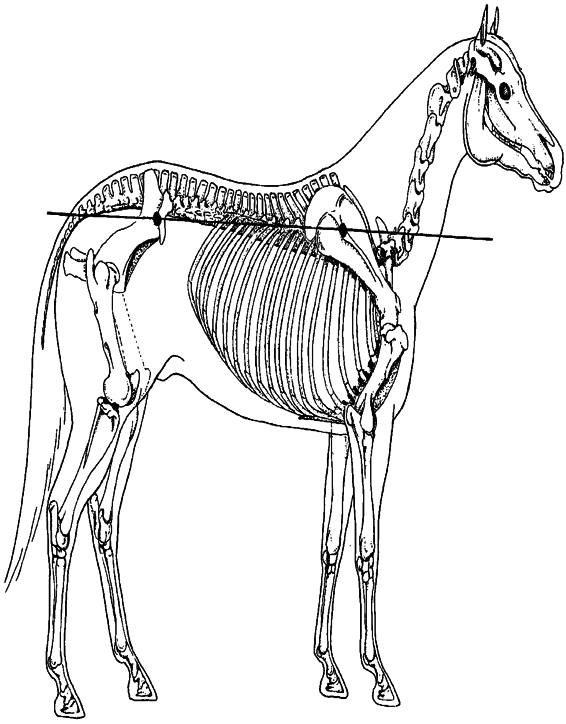
194
Equine Massage
amgr
t Line Dia
Floa
9.1
Conformation Check-up Routine
195
The walk is the best gait to use when checking for weak or sore muscles because the muscles are relaxed and move freely during this action. If there is restriction of muscular origin, you will see it readily at the walk, whereas during the trot the overall action of the muscles (working as a unit) would mask any specific muscle tension (i.e., the horse “works out” of the soreness).
The Trot
Repeat the previous drill, but this time with the horse trotting in the same sequence as mentioned in assessing movement at the walk.The trot should be supple and even, the gait springing, with joints well-flexed. Listen to the rhythmic two-beat cadence of the trot; it should be even. At this pace, a horse will definitely favor a hurt limb. If lameness at a walk is due to a sore muscle, the lameness might very well appear less pronounced at a trot.This is due to the masking effect of the muscle groups working strongly together at the faster gait. The horse should hold his head fairly steady at the trot.
If lame in a front leg, the horse will raise his head as the lame leg strikes the ground.
If lame in the hindquarters, the horse will drop his head as the lame leg strikes the ground.
Any lameness that is still obvious at a trot could indicate that the problem lies deeper, for example, in a ligament or joint.
Watch for:
❖
Dishing
(foot thrown outward), toe flipping.
❖
Plaiting/lacing
(placing one foot in front of the other due to a narrow chest).
❖
Brushing
(due to feet turned outward, hurt fetlock inside).
❖
Forging
(hind feet strike front feet).
The sound horse should hold his head fairly steady at the trot.
Record all your findings in a case study form (see chapter 16).
The conformation check-up routine helps you determine abnormalities and understand certain aspects of the signs and symptoms manifested by the horse. The ground check routine contributes greatly to your evaluation and helps you decide the best course of action for your horse’s treatment.
A solid knowledge of equine conformation is important as it helps
you better understand the different criteriums of selection for movement. So many breeds are available today that a classical understanding of proper conformation will assist you in evaluating
muscular conditions and faulty gaits.This understanding will build
up your confidence in your application of equine massage.
10
BODY PARTS AND THEIR
STRESS POINTS
To improve the quality of your work you need to know more about the stress points found in the horse’s head and neck, shoulders and forelegs, back and rib cage, and hindquarters and hind legs.
For each stress point (SP), you will learn:
❖ Its location in the muscle groups
❖ The motion it affects
❖ Its signs and symptoms
❖ The way it feels on palpation
❖ Important structures involved
In turn, such knowledge coupled with your massage skills will directly affect your horse’s performance capabilities, permitting greater flexibility and coordination and thus more power.
The Head and Neck
A horse uses his head and neck to keep the rest of his body in balance during motion. Therefore, the flexibility of both head and neck is vital to good performance.
The way the horse carries his head will affect his stride. A very high head carriage will cause very high leg action with a short stride. A long-necked horse with average head carriage will extend the leg and have a long stride. A short-necked horse with an average head carriage will bend the knees and have a short stride because of the short neck.
196
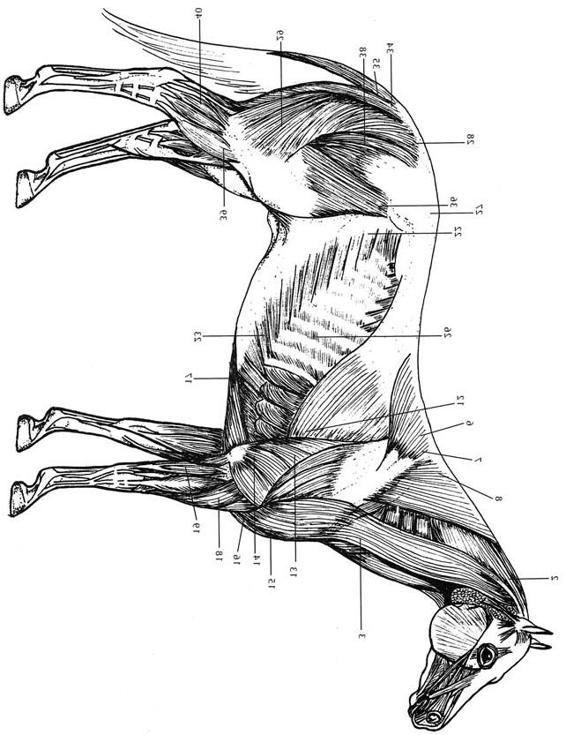
Body Parts and Their Stress Points
197
tion
oint Loca
ess P
yer with Str
le La
Superficial Musc
10.1
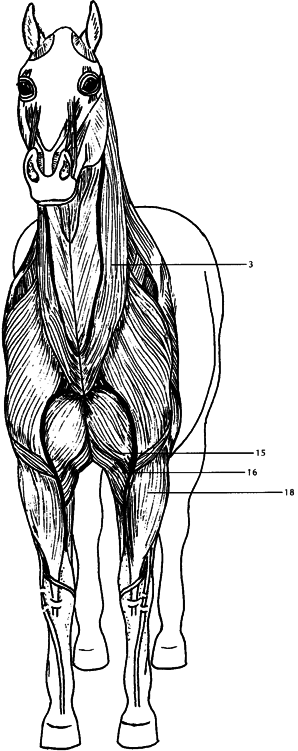
198
Equine Massage
10.2 Front Muscles with Stress Point Location
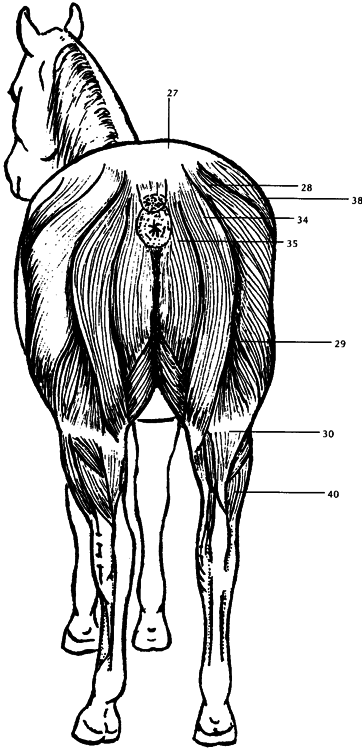
Body Parts and Their Stress Points
199
10.3 Back Muscles with Stress Point Location
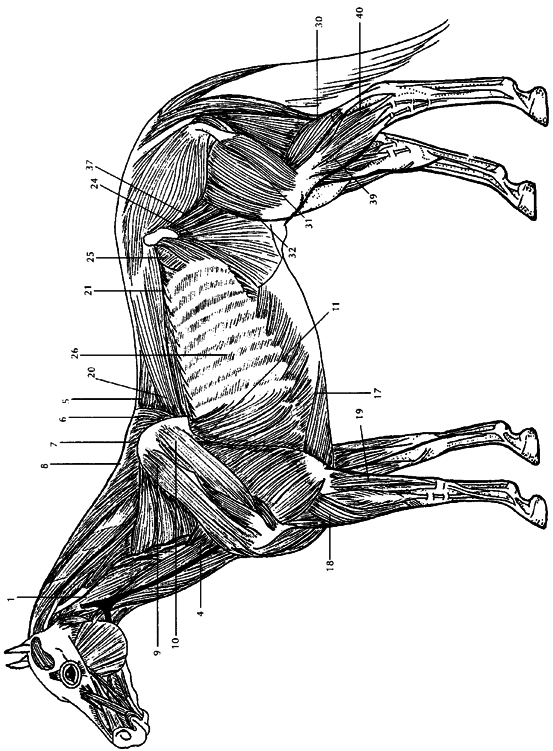
200
Equine Massage
tion
oint Loca
ess P
yer with Str
le La
Deep Musc
10.4

Body Parts and Their Stress Points
201
10.5 Head and Neck Section (Deep and Superficial Muscle Layers)
with Associated Stress Point Location
(A) Deep Muscle Layer
[5] scalene muscle
[1] SP 1 rectus capitis ventralis muscle
[6] intervertebral muscles
[2] SP 4 sternothyrohyoid and
omohyoid muscles
(B) Superficial Muscle Layer
[3] ligamentum nuchae
[7] SP 2 splenius cervicis muscle
[4] serratus cervicis muscle
[8] SP 3 brachiocephalic muscle
A heavy head will create more stress on the neck, especially if the neck is long. The lighter the head, proportionally, the better.
The angle of the head relative to the neck will affect breathing.
A good neck is one of a horse’s most important features. A long neck gives a horse a mechanical advantage in balancing himself by making a wide range of adjustments along the length of his body during any athletic movements. The 7 cervical vertebrae have considerable lateral and vertical flexibility; they act as a blueprint for the shape of the neck. The cervical spine curves twice like a gentle “S” seen from the right side. The length of the neck varies from breed to breed because each breed has different sizes of vertebrae. The “S” curve is extreme in Saddlebreds, average in Thoroughbreds, and almost flat in Quarter Horses.
The ligamentum nuchae (nuchal ligament) is a strong ligament that runs from the poll to the withers, where the splenius muscle attaches to it.When the splenius muscle contracts it raises the neck; it lowers the neck as the muscle relaxes.The multifidus cervices and the rectus capitis lateralis muscles assist lateral rotation of the head. Remember that during motion all the muscle groups of the body work at once, ever ready to assist the horse in any situation.
202
Equine Massage
#1 Stress Point—The Rectus Capitis
Ventralis Muscle
Myology:
The rectus capitis ventralis muscle (located in the deep layer) is found on each side of the neck attaching to the cervical vertebrae, running forward to anchor at the base of the skull. It flexes the head and assists the lateral rotation of the head.
Signs and Symptoms:
When this muscle is tight the horse shows discomfort, pulling the head to that side, resisting sideways motion to the opposite side and continuously stretching the neck and head. At rest, the horse will have a tendency to keep his head low, continuously stretching it to relieve muscular tension. In motion, he will clearly show head discomfort.
Treatment:
When you apply pressure to SP 1, the horse will respond with some skin twitching along the neck and by dropping his head. If the stress point is very tender the horse will flinch and perhaps try to pull away from the pressure.This is a sign of excessive tightness and stress; if you feel heat, suspect inflammation.
Stress Point 1 is located on the origin tendon, third cervical vertebra. The whole muscle will feel tight from its origin all the way to its attachment on the skull. It may feel very tender to the horse.
#2 Stress Point—The Splenius
Cervicis Muscle
Myology:
The splenius cervicis (located in the superficial layer) is on each side of the neck, attaching on the base of the skull and upper cervical vertebrae and running parallel toward the body to anchor along the first thoracic vertebra.When both sides contract simultaneously, they extend the neck, bringing the head up (extension). When contracting unilaterally, the muscle turns the head and neck to the side (lateral flexion).